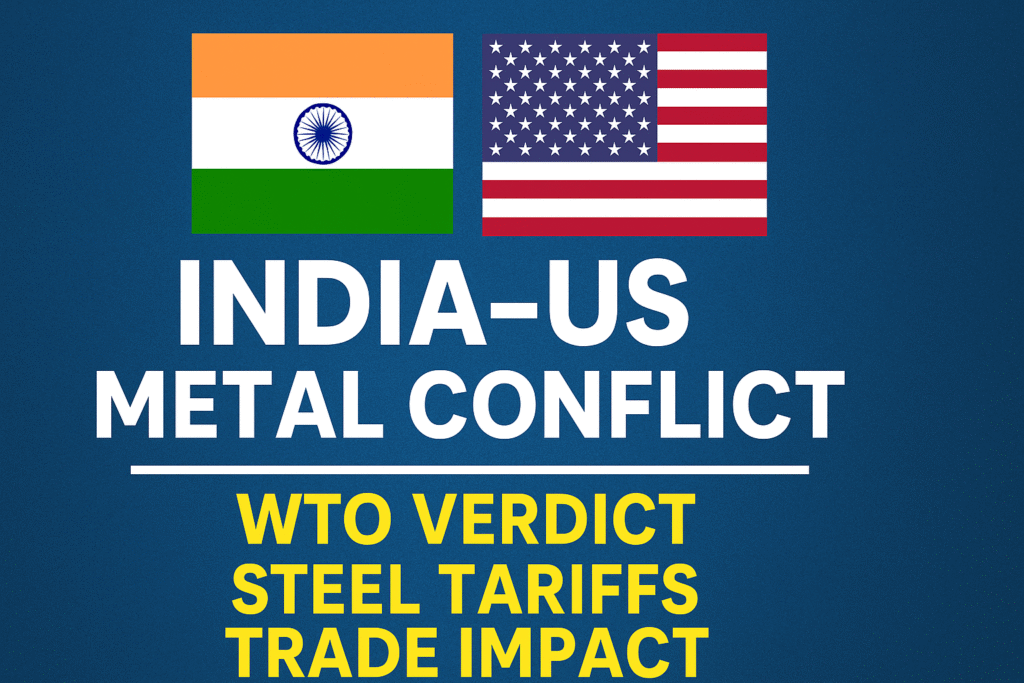India-US Metal Conflict: Steel Tariffs, Trade Retaliation, and WTO Clash
Why are India and the US clashing over steel and aluminium? This ongoing trade conflict isn’t just about tariffs—it’s about economic power, global rules, and strategic diplomacy. In this blog, we break down the full story behind the India-US metal conflict, the WTO’s role, and its impact on India’s economy.
🌐 What Triggered the India-US Metal Dispute?
In March 2018, the US imposed 25% tariffs on steel and 10% tariffs on aluminium imports under Section 232 of the Trade Expansion Act, citing “national security concerns.” These duties applied to several countries—including India.
India’s Reaction to the US Tariffs
- India strongly objected and termed the move as discriminatory and unjustified.
- It filed a complaint at the World Trade Organization (WTO).
- India also announced retaliatory tariffs on 28 US products such as almonds, walnuts, and apples.
⚖️ WTO Ruling Favors India
In December 2022, a WTO panel ruled in India’s favour, stating that the US action violated international trade laws.
Key WTO Observations:
- The US could not justify its tariffs under the “national security” exception.
- The ruling empowered India to seek compensation or impose retaliatory measures.
US Response
- The US rejected the ruling and did not remove the tariffs.
- This intensified tensions and kept the trade conflict alive through 2024 and into 2025.
🧾 India Revises Its Retaliatory Duties (July 2025 Update)
India has now revised its proposed retaliatory tariffs against US goods at the WTO. The list targets American products with high export value.

Targeted US Products:
- Fresh apples
- Almonds and walnuts
- Industrial equipment
- Motorcycles and electrical machinery
This move is part of a larger strategy to balance trade losses due to the metal tariffs while signaling India’s stand on fair trade practices.
💥 Impact on India’s Steel & Aluminium Industry
The tariffs hurt Indian exporters, leading to loss of revenue and restricted access to the American market.
Economic Effects:
- Steel exports to the US dropped significantly after 2018.
- Loss of approximately $1.5 billion in potential trade revenue annually.
- Manufacturers faced increased competition and global price instability.
India’s Strategy Going Forward:
- Expand steel and aluminium exports to new markets like Southeast Asia and the EU.
- Invest in value-added production and domestic demand stimulation.
- Push for reforms through global forums like the WTO and G20.
🔍 Why This Dispute Matters for Global Trade
The India-US metal conflict highlights growing trade protectionism in the post-pandemic world. As major economies compete for manufacturing dominance, smaller and developing economies must carefully navigate through.
Key Lessons:
- Strong economies must still follow global trade rules.
- Disputes should be resolved diplomatically, not unilaterally.
- India’s balanced response sets an example for rules-based international order.
📚 Recommended Reading
- Mint Report on India Revising Retaliatory Duties (2025)
- WTO Case File on US Steel Tariffs
- More Blogs by This Author on Trade & Economy
📢 Final Thoughts: India Must Stay Strong, Yet Strategic
India’s calculated approach in challenging the US and utilizing WTO frameworks shows maturity in global trade policy. The steel and aluminium sectors are vital to India’s manufacturing growth under the Make in India mission.
While diplomatic engagement must continue, India is also asserting its right to protect its economy and workers.
✅ Summary Points:
- India-US metal conflict began due to US national security tariffs in 2018.
- WTO ruled in India’s favour but the US refused to comply.
- India revised its list of US products to target for retaliatory tariffs.
- The move defends Indian industry and supports global trade law.
💬 What’s Your Opinion?
Do you think India should continue retaliatory duties or seek a fresh trade deal? What’s the best way to handle rising trade protectionism?
👇 Leave your thoughts in the comments or read more expert articles here.
✅ If you found this article helpful, please share it with your network!

